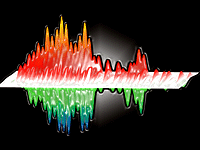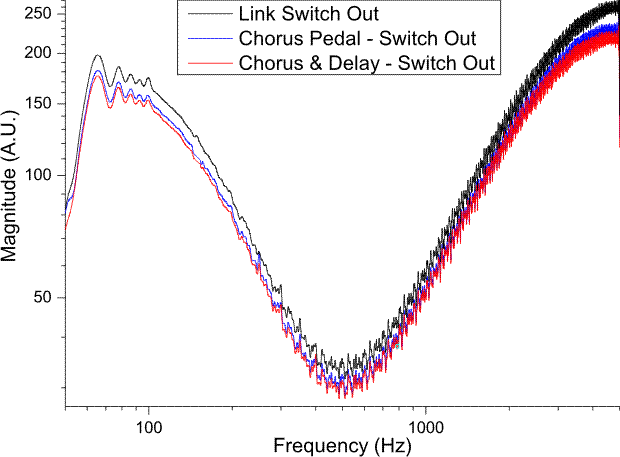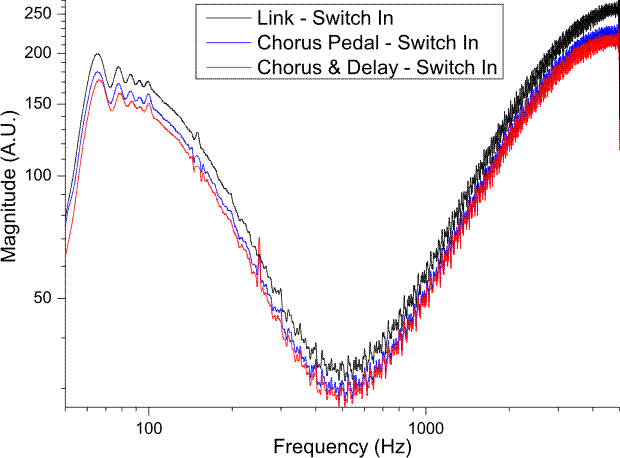 |
 |
| Home | Software | Guitar Amps etc. | Publications | Secure | Contact |
| Main Amp Page | DSL Clean/Crunch Footswitch | DSL FX Loop Modification | DSL FX Loop Measurements |
JCM2000 Marshall DSL 50 / 100 FX Loop Measurements |
|||
IntroductionTo understand reports that the Marshall DSL effect loop begins to suck tone as the volume is turned up, the frequency response of the amplifier has been measured under different conditions and at different volumes. To measure the response, a swept sine wave from 50-5000Hz was sent into the input jack of the amplifier at a level representative of a humbucking guitar pickup. Tests were performed on the green channel with the gain set so that the signal remained as clean as possible whilst still maintaining a decent output volume - level 6, crunch button not pressed. The output of the amplifier was recording using the line out jack of an 8Ohm THD Hotplate set to LOAD - i.e. disconnected from the actual speaker. The response of the amplifier, at different volumes, under the following conditions was measured:
In an ideal world, at each volume level, the results from tests 2-7 would be identical to the non FX loop, test 1. However, when the FX loop is enabled the signal is first attenuated, buffered and the re-amplified back up to the original volume. Due to component tolerances which are likely to be greater than 1%, there may be some slight overall amplfication or attenuation when the loop is used with either the +4 / -10 dB settings. As such, the measured response with pedals in the chain are compared to the relevent +4 or -10 dB setting jumpered tests, 2 or 3.
|
|||
Green Channel, Gain 6, Volume 3Loop disabled vs. Jumpered Loop +4 / -10dB
These results show that the effects loop itself does very little to the response of the amplifier. There is a slight increase in the signal levels at all frequencies for both loop settings over the standard response, around 3%. At higher frequencies, the loop responses increase slightly to 4% over the non loop response. Such a small change would be difficult to notice in practise. This result is promising, showing that the effects loop itself is transparent at these volume levels. Jumpered Loop vs. Loop with effects (Boss) turned off - 10dB
With the pedals in the chain, things start to look a little worse! With a single pedal in the chain (the CE-5) the overall signal levels drops by 8.5%. With both pedals in the chain, the signal drops by a 11.2%. However, most importantly, the frequency response is not affected - just the overall signal level. This will cause problems if your setup can enable/disable the effects loop - when enabled, the signal will be reduced in volume and if you are relying on power tube distortion, this will be reduced as the signal level drops - affecting your tone. At this point, I would attribute the losses to the pedals rather than the amplifier as the loop itself did prove pretty transparent. Jumpered Loop vs. Loop with effects (Boss) turned off - +4dB
At the +4dB setting, the pedals still show a pretty good frequency response, however the volume loss is slightly worsened. With the single chorus pedal the level drops by 9.7%, with both pedals it drops by 13.7%. Results so far show that volume drop by the pedals increases with increased volume. Foot pedals should normally be used on the -10dB setting to keep the signal levels within their operating parameters. However with my 2 pedals in question, there was no noticable distortion when used at the +4dB setting.
|
|||
Green Channel, Gain 6, Volume 5 - To Follow |
|||
|
|||
|
|||
|
|||
|
|||


